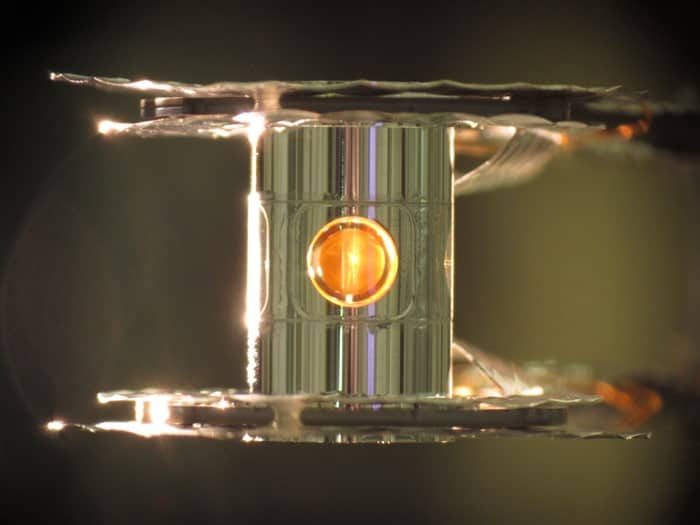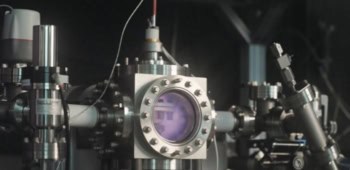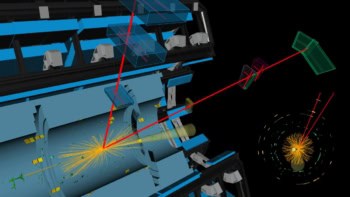
Inertial confinement fusion (ICF) experiments have been improved by a new computer algorithm that analyses statistical correlations between previous results. The program was created by researchers in the US, who have already used it to triple the energy yield in a small-scale ICF experiment. The researchers hope that the algorithm could be used to achieve “ignition” in future ICF experiments.
In ICF, a tiny pellet of hydrogen isotopes is compressed by powerful lasers to such high densities that the nuclei fuse into helium. In principle, the energy released from this reaction could be greater than the energy delivered by the lasers and the excess energy could be used to produce electricity. Achieving this in practice, however, depends on taming instabilities in the highly compressed plasma.
The details of ICF experiments vary, but they almost all begin with powerful lasers compressing a millimetre-size pellet of deuterium and tritium nuclei. As the pressure and temperature in the “hot spot” at the core of the pellet rise, nuclear fusion occurs. This, however, is the easy part. To produce a practical source of energy, the fusion at the centre would need to be sufficiently intense to ignite fusion throughout the rest of the pellet.
Sparking fusion
“When you ignite gasoline, you start from a spark – that would be the hot spot,” explains Riccardo Betti of the Laboratory for Laser Energetics (LLE) at New York’s University of Rochester. Betti, who was part of the team that created the algorithm adds, “If the spark is strong enough you get enough power to ignite the fuel, and then you get a lot of power. It’s the same for fusion.”
Achieving ignition has been a goal of researchers working at the National Ignition Facility (NIF) at Lawrence Livermore National Laboratory in California – which is the largest laser facility ever built. Although much has been learned about ICF at NIF, it has yet to achieve this goal.
A central challenge is controlling instabilities that occur in the plasma under such extreme conditions. “You can change many things in an implosion,” says Betti, “You can change the target geometry and composition, you can change the laser pulse shape…The parameter space is so big and the number of shots you can take with a laser – especially NIF – is so limited, that you cannot just empirically sample the whole parameter space.”
Lack of resources
Computer models are essential to select which combinations of parameters are tested experimentally. In principle, the perfect computer model could determine the ideal combination of parameters, so researchers would only need to run one experiment. “If we could run the simulations with all the phenomena perfectly resolved in 3D in a reasonable amount of time, we could probably have already designed a high-performing target,” says the LLE’s Varchas Gopalaswamy. “Unfortunately, there’s nowhere on the planet with the computing resources to do this.”
Gopalaswamy and colleagues studied results from the LLE’s OMEGA laser, which can focus 30 kJ of energy onto a pellet. Since 2005, OMEGA has conducted about 80,000 experimental runs. The team compared computer simulations with the actual experimental results and developed a statistical program to extrapolate predictions of parameter combinations that could yield better results. The researchers then tested these new predictions, fed the new results back into the program and used an iterative process to find even better configurations.
“You guys are out of your minds!”
The researchers then ran experiments on OMEGA using parameters suggested by the algorithm and were able to triple the fusion yield relative to previous experiments. “The best performing run used a laser pulse that we would not have chosen from first principles,” says Michael Campbell, the LLE’s director, “When Riccardo and Varchas first showed it to me, I said ‘You guys are out of your minds!'”.

Laser fusion passes milestone
OMEGA cannot ignite a fusion reaction, but if similar experiments were done at NIF the researchers estimate that this could lead to a fusion yield of 500 kJ. This is several times higher than the present record, and well on the way to ignition. Betti cautions, however, that “NIF is not just bigger, it’s also different, so scaling to NIF will be tricky.”
Stefano Atzeni of the Sapienza University of Rome, an expert in modelling nuclear fusion, describes the research as a “new paradigm” that is needed because it has become apparent that ICF simulations are not as accurate as had been hoped.
The research is described in Nature.
- Tune into this episode of the Physics World 30th anniversary podcast series, which focuses on fusion energy.



